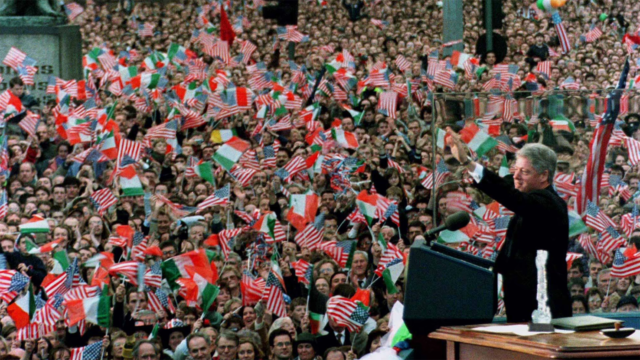By Mary Kate Montgomery | Guest Contributor
The perspective of the Irish toward Americans has transcended over time, thanks to the help of United States Presidents Bill Clinton and Barack Obama. The immigration history of the Irish has contributed to the way the Irish view all travelers and cultures.
Relations between the United States and Ireland are rooted in strong ancestral lineage and economic partnership. The United States is known to be Ireland’s biggest ally and trade partner, according to the U.S. Department of State.
Dublin local and pub marketing manager Damien Cunningham said due to the partnership between these two countries, the Irish make intentional efforts to ensure Americans feel welcome when visiting the country.
“You can ask any Irish person, and they will have a connection to America in one way or another,” Cunningham said. “We are proud of that relationship.”
In order to receive a J1 visa, one must apply for a certificate of eligibility that sponsors an organization to travel abroad to work for a summer.
“A lot of Irish people will go over to America on a J1 visa, which is often in the summer when you are in your first or second year of college,” Cunningham said. “I want to experience maybe New York, LA or the real fun one for me: Texas. Like here in Ireland, there is such a strong culture and identity when you walk into a place. I want to go and get that big hat you see in movies. It’s the strong culture that you want when you go on vacation.”
Cunningham said the Irish love Americans because they bring a lot of joy and, like themselves, they love having craic — the Irish word for fun. He said he believes Americans are on board with the lifestyle dedicated to having fun.
The strong relationship between the United States and Ireland dates back to the fall of 1995 when Northern Ireland awaited the visit from Clinton. The historic visit of the 42nd president of the United States embraced the relations between the Republic of Ireland and Northern Ireland.
“There is a real synonymous love for Bill Clinton here,” Cunningham said. “We’re such a small little island, and the USA is huge, so to see someone speak about our topics on an international scale is amazing for us. It makes us feel like we are on the map.”

Lois Totton — a senior lecturer at Stranmillis University College in Belfast, Northern Ireland — stood hand in hand with Clinton outside of the local bank on Nov. 30, 1995.
“He shook my hand,” Totton said. “It was a day I will never forget.”
Clinton set the standard for future American presidents in Ireland.
Off the M7 Motorway, the route between Limerick and Dublin, the Barack Obama Plaza sits on R445 Road to work as a service state for passing travelers. The plaza also serves to honor the respects the Obama family paid to the country in 2011.
Cunningham said visits like Clinton’s and Obama’s have changed the way the Irish view Americans for the better.
“There is a famous picture where he is at a bar in Moneygall surrounded by his distant family,” Cunningham said. “We see him on TV, but to see him like a normal person in the midst of the pub with all the locals really endeared him to us, because that is our culture.”

Today, tourism has become an important aspect of Ireland. According to the Department of Tourism, Culture, Arts, Gaeltacht, Sport and Media, tourism supports around 325,000 jobs on the island of Ireland.
“Ireland is synonymous with tourism, so it is a crucial part of the economy for us,” Cunningham said. “A lot of people want to be here. Maybe that was not the case 20 years ago, but it comes from tourism and all comes back to the culture.”
Dublin is now a multicultural city, whereas decades ago, Irish people tended to keep to themselves and refuse to travel.
“There is history behind it, like how we left the country during the famine,” Cunningham said. “We had to leave here and now have seen how other people have accepted us in other countries. The kindness of people here is aimed to accept, just how we were accepted decades ago.”
Galway local and server Larry McMillian said he was fascinated about getting to serve Americans in the hotel restaurant he works in. He said he was getting complaints from other tables about not getting proper service because he was spending too much time with the American lot.
McMillian said he had a hard time understanding why groups decided to come to Ireland out of all places for a study abroad.
“But why Ireland?” McMillian said. “All we do is drink, and it rains all the time. America is so grand compared to this.”
McMillian said he has a certain gratitude for serving American customers because he knows he will always get treated with respect and kindness from travelers.
Galway local and barista Colm O’Malley said he quickly picks up on American accents as he takes orders.
“When Americans enter my restaurant, I know my staff and I will be treated with respect,” O’Malley said. “America is the home of service. We love serving the Americans here. I mean it sincerely. Every time we go to the States, we get taken care of so well. It’s been two years since I’ve been back, and I’m having withdrawal symptoms.”
A popular Irish blessing of “May the road rise up to meet you” — meaning a blessing for one’s journey to be an easy one — is commonly given to travelers from near and far in Ireland.
Treating others as their own is something that the Irish continue to show to travelers, from the time American presidents visited to long after.



